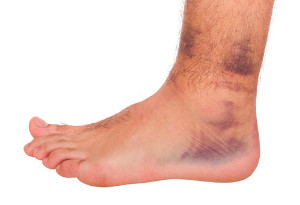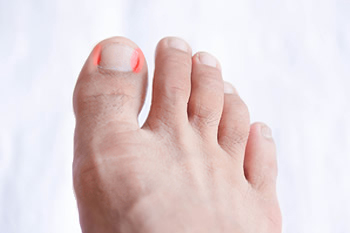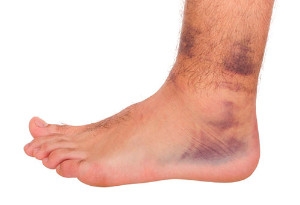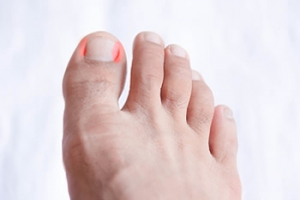
Wounds That Don't Heal Need to Be Checked
Painful Ankle Sprains
 There are ligaments and tendons that surround the ankle which connect the bones to the feet. If an injury should occur that stretches or tears the tendons, the result may be an ankle sprain. A common reason ankle sprains occur may come from twisting the ankle by suddenly stepping off a curb. The typical symptoms that many patients experience can be severe pain and discomfort, swelling, and it may be difficult to walk. After a proper diagnosis is performed, which generally includes having an X-ray taken, the proper treatment can begin. The affected foot may feel better when it is wrapped with an elastic bandage, and this may help to provide adequate support. For severe sprains, it may be impossible to put any weight on the foot, and crutches may be needed for mobility. There are measures that can be taken which may reduce the risk of enduring a sprained ankle. These may include wearing shoes that fit properly, performing exercises that can strengthen the ankles, and being aware when walking on uneven surfaces. If you have sprained your ankle, it is advised that you consult with a podiatrist who can discuss the best treatment options for you.
There are ligaments and tendons that surround the ankle which connect the bones to the feet. If an injury should occur that stretches or tears the tendons, the result may be an ankle sprain. A common reason ankle sprains occur may come from twisting the ankle by suddenly stepping off a curb. The typical symptoms that many patients experience can be severe pain and discomfort, swelling, and it may be difficult to walk. After a proper diagnosis is performed, which generally includes having an X-ray taken, the proper treatment can begin. The affected foot may feel better when it is wrapped with an elastic bandage, and this may help to provide adequate support. For severe sprains, it may be impossible to put any weight on the foot, and crutches may be needed for mobility. There are measures that can be taken which may reduce the risk of enduring a sprained ankle. These may include wearing shoes that fit properly, performing exercises that can strengthen the ankles, and being aware when walking on uneven surfaces. If you have sprained your ankle, it is advised that you consult with a podiatrist who can discuss the best treatment options for you.
Ankle sprains are common but need immediate attention. If you need your feet checked, contact one of our podiatrists from Bazzi Podiatry. Our doctors can provide the care you need to keep you pain-free and on your feet.
How Does an Ankle Sprain Occur?
Ankle sprains take place when the ligaments in your ankle are torn or stretched beyond their limits. There are multiple ways that the ankle can become injured, including twisting or rolling over onto your ankle, putting undue stress on it, or causing trauma to the ankle itself.
What Are the Symptoms?
- Mild to moderate bruising
- Limited mobility
- Swelling
- Discoloration of the skin (depending on severity)
Preventing a Sprain
- Wearing appropriate shoes for the occasion
- Stretching before exercises and sports
- Knowing your limits
Treatment of a Sprain
Treatment of a sprain depends on the severity. Many times, people are told to rest and remain off their feet completely, while others are given an air cast. If the sprain is very severe, surgery may be required.
If you have suffered an ankle sprain previously, you may want to consider additional support such as a brace and regular exercises to strengthen the ankle.
If you have any questions please feel free to contact one of our offices located in Detroit, West Detroit, Northwest Detroit, Sterling Heights, Hamtramck, Dearborn Heights, Madison Heights, Redford, and Livonia, MI . We offer the newest diagnostic and treatment technologies for all your foot and ankle needs.
Ankle Sprains
Although ankle sprains may not be as serious as a broken ankle, they should be given immediate attention and care. An ankle sprain can lead to a significant amount of pain, as well as limited mobility. They are often characterized by the swelling and discoloration of the skin. This occurs when the ligaments are stretched beyond their limits.
The simple act of walking can sometimes cause a sprain, which makes ankle sprains a very common injury that can happen to anyone. They occur when the ankle twists in an awkward way or rolls over itself, causing a pop or snap in the tendons around the ankle. Some people are more at risk than others. These include athletes who continually push their bodies to the limits and also people who have previously suffered accidents to the feet, ankles, or lower legs.
Most of the time, an ankle sprain is not severe enough for hospital attention. There are many at-home treatment options available, including propping the leg up above your head to reduce blood flow and inflammation, applying ice packs to the affected area as needed, taking over-the-counter pain relievers and anti-inflammatory medication, using an ACE bandage to wrap and support the injured ankle, and most importantly, remaining off your feet until the ankle has fully healed.
Despite this, an ankle sprain can turn into a severe injury that might require hospitalization. If the ankle ligaments or muscles are damaged from a tear or rip, that is one sign that the sprain is severe enough for hospital attention and possibly for surgery. Even after the surgery, the recovery process can be long. You may need to have rehabilitation sessions administered by your podiatrist to get your ankle back to full health.
The severity of your sprain might become apparent if you are unable to stand or walk, consistent pain occurs over a prolonged period of time, swelling is much more severe than initially present, or if you start to experience tingling or numbness. These signs may indicate that your ankle sprain might actually be a broken ankle, an injury that requires immediate medical attention.
Although they are not completely avoidable, ankle sprains can be curbed with some preventative treatment measures. These include wearing appropriate-fitting shoes that not only provide a comfortable fit, but also ankle support. It is also recommended to stretch before doing any kind of physical activity, as this will help lower your body’s chance for an injury.
Why Do Corns Develop?
 A small, hardened portion of skin on top of the toe may be referred to as a corn. It may appear to be yellow, and can cause considerable pain while wearing shoes. They can also form in between the toes, and on the bottom of the feet. A common reason why corns can develop is a result of excess friction that may come from wearing shoes that do not fit correctly. Patients who are afflicted with corns may find moderate relief when the foot is soaked in warm water. This may help to soften the affected area, followed by filing with a pumice stone. If it is painful to complete daily activities, wearing a corn pad over the corn may provide adequate cushioning that is needed for temporary relief. If you have a corn on any part of your foot, it is advised that you seek the counsel of a podiatrist who can offer permanent treatment options.
A small, hardened portion of skin on top of the toe may be referred to as a corn. It may appear to be yellow, and can cause considerable pain while wearing shoes. They can also form in between the toes, and on the bottom of the feet. A common reason why corns can develop is a result of excess friction that may come from wearing shoes that do not fit correctly. Patients who are afflicted with corns may find moderate relief when the foot is soaked in warm water. This may help to soften the affected area, followed by filing with a pumice stone. If it is painful to complete daily activities, wearing a corn pad over the corn may provide adequate cushioning that is needed for temporary relief. If you have a corn on any part of your foot, it is advised that you seek the counsel of a podiatrist who can offer permanent treatment options.
Corns can make walking very painful and should be treated immediately. If you have questions regarding your feet and ankles, contact one of our podiatrists of Bazzi Podiatry. Our doctors will treat your foot and ankle needs.
Corns: What Are They? And How Do You Get Rid of Them?
Corns are thickened areas on the skin that can become painful. They are caused by excessive pressure and friction on the skin. Corns press into the deeper layers of the skin and are usually round in shape.
Ways to Prevent Corns
There are many ways to get rid of painful corns such as:
- Wearing properly fitting shoes that have been measured by a professional
- Wearing shoes that are not sharply pointed or have high heels
- Wearing only shoes that offer support
Treating Corns
Although most corns slowly disappear when the friction or pressure stops, this isn’t always the case. Consult with your podiatrist to determine the best treatment option for your case of corns.
If you have any questions please feel free to contact one of our offices located in Detroit, West Detroit, Northwest Detroit, Sterling Heights, Hamtramck, Dearborn Heights, Madison Heights, Redford, and Livonia, MI . We offer the newest diagnostic and treatment technologies for all your foot and ankle needs.
Solutions for Cracked Heels
Cracked heels can make life very frustrating and embarrassing when displaying the bare feet. Aside from being unpleasing to the eye, they can also tear stockings and socks and wear out shoes at a faster rate. When severe, cracked heels may cause pain or infection.
Cracked heels are a problem for those who are athletic, those who may walk a lot, and those who have especially dry skin. Those who use medication that dry the skin, those who swim often, wearing certain types of shoes, and those who are diabetic may have trouble with cracked heels. Seniors whose skin produces less oil may also have trouble with cracked feet. There is no one way to develop cracked feet, and there is no cure.
Today, the market consists of numerous products that have a variety of ingredients to promote healing. Some of these are over-the-counter. Others are prescribed by a doctor, especially for those who have chronic dry feet and heels.
Some doctors recommend wearing socks at night for those with rough skin. This helps further healing, and helps creams stay on longer and better absorb into the skin.
One way to alleviate dryness that causes cracked heels is by using moisturizers both day and night. Another way is to make sure the skin is clean and dry at all times. Using a pumice stone to buff away dead skin before putting on moisturizer can also help. Cracked heels will not respond to the cream unless the outer layer of skin is first removed through exfoliation. After exfoliation, lotion or ointment will be absorbed by the skin more easily.
Foods that produce healing and balance can also help the skin from within. Everything that is put into the body can either help it or hurt it. Taking supplements of omega-3 fatty acids and zinc can also be very beneficial.
Nevertheless, not all products are guaranteed to help treat cracked feet. Seeing a professional is best if other treatments options were unsuccessful. A podiatrist should be able to give the best advice to help with this problem.
Possible Causes of Ingrown Toenails
 When a toenail grows into the skin instead of over it, it is referred to as an ingrown toenail. The symptoms that are often accompanied with this condition can consist of tenderness, redness, and swelling. Common reasons for this condition to manifest may include wearing shoes that do not have adequate room for the toes to move freely in, cutting the toenail too short, or from an injury that has happened to the toe. Patients who have ingrown toenails that are not infected may find mild relief when the foot is soaked in warm water. This may enable you to gently move the nail away from the skin it has grown into. If you have developed this ailment, it is suggested that you consult with a podiatrist who can properly treat infected and uncomfortable ingrown toenails.
When a toenail grows into the skin instead of over it, it is referred to as an ingrown toenail. The symptoms that are often accompanied with this condition can consist of tenderness, redness, and swelling. Common reasons for this condition to manifest may include wearing shoes that do not have adequate room for the toes to move freely in, cutting the toenail too short, or from an injury that has happened to the toe. Patients who have ingrown toenails that are not infected may find mild relief when the foot is soaked in warm water. This may enable you to gently move the nail away from the skin it has grown into. If you have developed this ailment, it is suggested that you consult with a podiatrist who can properly treat infected and uncomfortable ingrown toenails.
Ingrown toenails may initially present themselves as a minor discomfort, but they may progress into an infection in the skin without proper treatment. For more information about ingrown toenails, contact one of our podiatrists of Bazzi Podiatry. Our doctors can provide the care you need to keep you pain-free and on your feet.
Ingrown Toenails
Ingrown toenails are caused when the corner or side of a toenail grows into the soft flesh surrounding it. They often result in redness, swelling, pain, and in some cases, infection. This condition typically affects the big toe and may recur if it is not treated properly.
Causes
- Improper toenail trimming
- Genetics
- Improper shoe fitting
- Injury from pedicures or nail picking
- Abnormal gait
- Poor hygiene
You are more likely to develop an ingrown toenail if you are obese, have diabetes, arthritis, or have any fungal infection in your nails. Additionally, people who have foot or toe deformities are at a higher risk of developing an ingrown toenail.
Symptoms
Some symptoms of ingrown toenails are redness, swelling, and pain. In rare cases, there may be a yellowish drainage coming from the nail.
Treatment
Ignoring an ingrown toenail can have serious complications. Infections of the nail border can progress to a deeper soft-tissue infection, which can then turn into a bone infection. You should always speak with your podiatrist if you suspect you have an ingrown toenail, especially if you have diabetes or poor circulation.
If you have any questions, please feel free to contact one of our offices located in Detroit, West Detroit, Northwest Detroit, Sterling Heights, Hamtramck, Dearborn Heights, Madison Heights, Redford, and Livonia, MI . We offer the newest diagnostic and treatment technologies for all your foot care needs.
Plantar Fasciitis
The plantar fascia is a connective tissue in the heel that stretches across the bottom length of your foot. Plantar fasciitis occurs when the connective tissue becomes inflamed, causing heel pain and discomfort during physical activity. Although the condition is completely treatable, traditional methods can take up to a year to start becoming effective.
Plantar fasciitis is caused by a number of everyday activities, so understanding the condition is important for managing and treating it. One of the most common causes of plantar fasciitis is excessive running, especially with improper fitting or non-supportive shoes. Too much exercise can lead to the plantar fascia being overworked and overstretched, which can cause tears in the tissue. Along with improper fitting shoes, pronation, the rolling of the feet inward, is a common cause of plantar fasciitis. If not treated properly, the plantar fascia becomes overstretched and starts to tear, causing inflammation.
Despite the common causes of plantar fasciitis, there are many different treatment options. For less severe cases, conservative home remedies include taking anti-inflammatory drugs to alleviate pain, applying ice packs to the bottom of your foot and heel, slowly stretching and exercising your feet to re-strengthen the tissue, and using orthotic devices are all ways to help manage your plantar fasciitis.
For more severe cases, shockwave therapy has become a common solution for plantar fasciitis. Shockwave therapy can effectively break up the tissue on the bottom of your foot which facilitates healing and regeneration. This fights the chronic pain caused by plantar fasciitis. Even if this doesn’t work, surgery is always a final option. Surgery on the tissue itself can be done to permanently correct the issue and stop the inflammation and pain in your heels.
No matter what the case may be, consulting your podiatrist is the first and best step to recovery. Even the slightest amount of heel pain could be the first stage of plantar fasciitis. Untreated symptoms can lead to the tearing and overstretching of tissue. Because the tearing of tissue can be compounded if it remains ignored, it can evolve into a severe case. The solution is early detection and early treatment. Talk to your podiatrist about the possibilities of plantar fasciitis if you’re experiencing heel pain.
U.S. Forward Suffers Ankle Sprain
 Jayson Tatum, forward for the Boston Celtics and currently playing for the U.S. men's national basketball team at the World Cup, suffered a sprained ankle during the American win over Turkey on Tuesday, September 3rd. The game went into overtime and ended with the U.S. prevailing 93-92. The sprain occurred in the course of the game’s final possession and was confirmed the following day after tests. “I think I just slipped and fell the wrong way,” said Tatum of the injury. The consequential sprain kept Tatum out of the Americans’ games against Japan and Greece. Fortunately, Brad Stevens, coach of the Boston Celtics, expressed that the ankle sprain wasn’t serious. If you’re suffering from a sprained ankle, consult with your podiatrist for a proper evaluation.
Jayson Tatum, forward for the Boston Celtics and currently playing for the U.S. men's national basketball team at the World Cup, suffered a sprained ankle during the American win over Turkey on Tuesday, September 3rd. The game went into overtime and ended with the U.S. prevailing 93-92. The sprain occurred in the course of the game’s final possession and was confirmed the following day after tests. “I think I just slipped and fell the wrong way,” said Tatum of the injury. The consequential sprain kept Tatum out of the Americans’ games against Japan and Greece. Fortunately, Brad Stevens, coach of the Boston Celtics, expressed that the ankle sprain wasn’t serious. If you’re suffering from a sprained ankle, consult with your podiatrist for a proper evaluation.
Although ankle sprains are common, they aren’t always minor injuries. If you need your ankle injury looked at, contact one of our podiatrists from Bazzi Podiatry. Our doctors can provide the care you need to keep you pain-free and on your feet.
How Does an Ankle Sprain Occur?
Ankle sprains are the result of a tear in the ligaments within the ankle. These injuries may happen when you make a rapid shifting movement while your foot is planted. A less common way to sprain your ankle is when your ankle rolls inward while your foot turns outward.
What Are the Symptoms?
- Pain at the sight of the tear
- Bruising/Swelling
- Ankle area is tender to touch
- In severe cases, may hear/feel something tear
- Skin discoloration
Preventing a Sprain
- Wearing appropriate shoes for the occasion
- Stretching before exercises and sports
- Knowing your limits
Treatment of a Sprain
In many cases, the RICE method (Rest, Ice, Compression, and Elevate) is used to treat ankle sprains. However, you should see a podiatrist to see which treatment option would work best with your injury. In severe cases, surgery may be required.
It is important to ask your doctor about rehab options after you receive treatment for your injury. Stretching, strength training, and balance exercises may help the ankle heal while also preventing further injury.
If you have any questions, please feel free to contact one of our offices located in Detroit, West Detroit, Northwest Detroit, Sterling Heights, Hamtramck, Dearborn Heights, Madison Heights, Redford, and Livonia, MI . We offer the newest diagnostic and treatment technologies for all your foot care needs.
Ankle Sprains
Ankle sprains occur when ligaments that support the ankle stretch beyond their limits and tear. These types of injuries are very common and can occur in people of all ages. Sprains may range from mild to severe, depending on how much damage is done to the ligaments. If a sprain goes untreated, a more severe sprain may occur which can further damage the ankle. Repeated ankle sprains can lead to chronic ankle pain.
There are some risk factors that can increase your risk of suffering a sprained ankle. Those who participate in sports, walk on uneven surfaces, have a prior ankle injury, are in poor physical condition, or wear improper shoes are more likely to get a sprained ankle.
There are a few symptoms to look out for if you suspect you are suffering from a sprained ankle. Some common symptoms are swelling, bruising, tenderness, and instability of the ankle. In cases where the tearing of the ligaments is severe, there may be a “popping” sound when the strain occurs.
The RICE method is proven to be effective in treating ankle sprains. RICE stands for Rest, Ice, Compression, and Elevation. Rest is important for treatment, especially within the first 24 to 48 hours. You should also ice your sprained ankle for the first 48 hours for 20 minutes at a time. A small piece of cloth should be placed between the ice and the affected area. For the compression step, you should wear a brace that is snug, but not too tight that it cuts off circulation. When choosing a brace, be sure to choose one that is suitable for the type of ankle sprain you have. Lastly, you should elevate your foot above the heart as often as possible.
After you treat a sprain, you should go through rehabilitation to prevent the injury from occurring again. There are three phases to the rehab process. The first phase involves resting, protecting, and reducing the swelling of the injury. The second phase consists of restoring the ankle’s flexibility, range of motion, and strength. The third phase consists of slowly returning to activity and maintenance exercises.
If you suspect you have an ankle sprain, you shouldn’t hesitate to consult with your podiatrist. Your podiatrist will be able to give you a proper diagnosis and a suitable treatment option for your condition.












